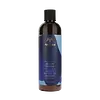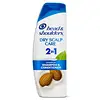What's inside
What's inside
 Key Ingredients
Key Ingredients

No key ingredients
 Benefits
Benefits

 Concerns
Concerns

 Ingredients Side-by-side
Ingredients Side-by-side

Water
Skin ConditioningLauramidopropyl Hydroxysultaine
CleansingSodium Cocoyl Isethionate
CleansingCocamide Mipa
EmulsifyingBetaine
HumectantRicinus Communis Seed Oil
MaskingSodium Isethionate
CleansingCetearyl Alcohol
EmollientSodium Chloride
MaskingPiroctone Olamine
PreservativeCeramide NP
Skin ConditioningCeramide EOP
Skin ConditioningCeramide AP
Skin ConditioningPhytosphingosine
Skin ConditioningZanthoxylum Bungeanum Pericarp Extract
Skin ConditioningPhytosterols
Skin ConditioningHydroxypropyl Bislauramide Mea
EmollientHydroxypropyl Bisstearamide Mea
Skin ConditioningMentha Piperita Oil
MaskingMelaleuca Alternifolia Leaf Oil
AntioxidantMenthol
MaskingOlea Europaea Fruit Oil
MaskingPolyglyceryl-10 Laurate
Skin ConditioningGlycol Stearate
EmollientGlyceryl Stearate
EmollientSodium Lauroyl Lactylate
EmulsifyingSodium Cocoyl Glutamate
CleansingCoconut Acid
CleansingGlycerin
HumectantPolyquaternium-7
Stearic Acid
CleansingTrisodium Dicarboxymethyl Alaninate
Hydroxypropyl Cyclodextrin
MaskingCaprylyl Glycol
EmollientEthylhexylglycerin
Skin ConditioningSodium Benzoate
MaskingPotassium Sorbate
PreservativeCitric Acid
BufferingLimonene
PerfumingWater, Lauramidopropyl Hydroxysultaine, Sodium Cocoyl Isethionate, Cocamide Mipa, Betaine, Ricinus Communis Seed Oil, Sodium Isethionate, Cetearyl Alcohol, Sodium Chloride, Piroctone Olamine, Ceramide NP, Ceramide EOP, Ceramide AP, Phytosphingosine, Zanthoxylum Bungeanum Pericarp Extract, Phytosterols, Hydroxypropyl Bislauramide Mea, Hydroxypropyl Bisstearamide Mea, Mentha Piperita Oil, Melaleuca Alternifolia Leaf Oil, Menthol, Olea Europaea Fruit Oil, Polyglyceryl-10 Laurate, Glycol Stearate, Glyceryl Stearate, Sodium Lauroyl Lactylate, Sodium Cocoyl Glutamate, Coconut Acid, Glycerin, Polyquaternium-7, Stearic Acid, Trisodium Dicarboxymethyl Alaninate, Hydroxypropyl Cyclodextrin, Caprylyl Glycol, Ethylhexylglycerin, Sodium Benzoate, Potassium Sorbate, Citric Acid, Limonene
Zinc Pyrithione 1%
AntiseborrhoeicDimethiconol
EmollientWater
Skin ConditioningDimethicone
EmollientSodium Laureth Sulfate
CleansingSodium Benzoate
MaskingSodium Lauryl Sulfate
CleansingGuar Hydroxypropyltrimonium Chloride
Skin ConditioningCocamidopropyl Betaine
CleansingTea-Dodecylbenzenesulfonate
CleansingSodium Xylenesulfonate
Trideceth-10
CleansingZinc Carbonate
Magnesium Carbonate Hydroxide
BufferingGlycol Distearate
EmollientPrunus Amygdalus Dulcis Oil
Skin ConditioningParfum
MaskingBenzyl Alcohol
PerfumingSodium Chloride
MaskingMethylchloroisothiazolinone
PreservativeMethylisothiazolinone
PreservativeZinc Pyrithione 1%, Dimethiconol, Water, Dimethicone, Sodium Laureth Sulfate, Sodium Benzoate, Sodium Lauryl Sulfate, Guar Hydroxypropyltrimonium Chloride, Cocamidopropyl Betaine, Tea-Dodecylbenzenesulfonate, Sodium Xylenesulfonate, Trideceth-10, Zinc Carbonate, Magnesium Carbonate Hydroxide, Glycol Distearate, Prunus Amygdalus Dulcis Oil, Parfum, Benzyl Alcohol, Sodium Chloride, Methylchloroisothiazolinone, Methylisothiazolinone
 Reviews
Reviews

Ingredients Explained
These ingredients are found in both products.
Ingredients higher up in an ingredient list are typically present in a larger amount.
Sodium Benzoate is a preservative. It's used in both cosmetic and food products to inhibit the growth of mold and bacteria. It is typically produced synthetically.
Both the US FDA and EU Health Committee have approved the use of sodium benzoate. In the US, levels of 0.1% (of the total product) are allowed.
Sodium benzoate works as a preservative by inhibiting the growth of bacteria inside of cells. It prevents the cell from fermenting a type of sugar using an enzyme called phosphofructokinase.
It is the salt of benzoic acid. Foods containing sodium benzoate include soda, salad dressings, condiments, fruit juices, wines, and snack foods.
Studies for using ascorbic acid and sodium benzoate in cosmetics are lacking, especially in skincare routines with multiple steps.
We always recommend speaking with a professional, such as a dermatologist, if you have any concerns.
Learn more about Sodium BenzoateChances are, you eat sodium chloride every day. Sodium Chloride is also known as table salt.
This ingredient has many purposes in skincare: thickener, emulsifier, and exfoliator.
You'll most likely find this ingredient in cleansers where it is used to create a gel-like texture. As an emulsifier, it also prevents ingredients from separating.
There is much debate on whether this ingredient is comedogenic. The short answer - comedogenic ratings don't tell the whole story. Learn more about comegodenic ratings here.
The concensus about this ingredient causing acne seems to be divided. Research is needed to understand if this ingredient does cause acne.
Scrubs may use salt as the primary exfoliating ingredient.
Learn more about Sodium ChlorideWater. It's the most common cosmetic ingredient of all. You'll usually see it at the top of ingredient lists, meaning that it makes up the largest part of the product.
So why is it so popular? Water most often acts as a solvent - this means that it helps dissolve other ingredients into the formulation.
You'll also recognize water as that liquid we all need to stay alive. If you see this, drink a glass of water. Stay hydrated!
Learn more about Water